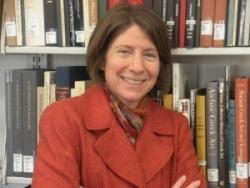Dr. Elise A. Friedland

Dr. Elise A. Friedland
Associate Professor of Classics and Art History, Art History Program
Programs: Art History
Contact:
Bio
Elise A. Friedland holds a BA in Classics from Williams College and an MA and PhD in Classical Art and Archaeology from the University of Michigan. Before coming to GW, she served as a Visiting Assistant Curator at the University of Michigan’s Kelsey Museum of Archaeology and taught for ten years at Rollins College in Winter Park, FL. Prof. Friedland has published two co-edited volumes, The Sculptural Environment of the Roman Near East: Reflections on Culture, Ideology, and Power (2008, Peeters Press) and The Oxford Handbook of Roman Sculpture (2015, OUP). as well as a monograph, The Roman Marble Sculptures from the Sanctuary of Pan at Caesarea Philippi/Panias (Israel) (2012, ASOR’s Archaeological Report Series). Based on a course she developed for GW, entitled “Greece and Rome in Washington, DC: Classical Influences on Our Founding Fathers,” Prof. Friedland is currently pursuing a new research project, “Pompeii on the Potomac: Brumidi’s Nineteenth-Century, Roman-Style Frescoes for the Naval Affairs Committee Room in the U.S. Capitol Building,” for which she has received a U.S. Capitol Historical Society Fellowship for Fall 2017. In 2013, she was awarded both GW’s Bender Teaching Award and the Archaeological Institute of America’s national Excellence in Undergraduate Teaching Award.
Current Research
Import, display, and meaning of marble sculpture from the Roman Near East
Role of religious statuary in the Roman Near East
Greek and Roman echoes in early and 19th c. American art
Education
1997 University of Michigan, Ph.D. in Classical Art and Archaeology
1994 University of Michigan, M.A. in Classical Art and Archaeology
1988 Williams College, B.A. in Classics, Magna Cum Laude
1986 Intercollegiate Center for Classical Studies in Rome
Publications
2015
The Oxford Handbook of Roman Sculpture (first editor; with Melanie Grunow Sobocinski and Elaine K. Gazda). Oxford University Press.
2012
The Roman Marble Sculptures from the Sanctuary of Pan at Caesarea Philippi/Panias (Israel). American Schools of Oriental Research, Archaeological Report Series 17.
“Marble sculpture in the Roman Near East: remarks on import, production, and impact,” in Ateliers and Artisans in Roman Art and Archaeology, T. M. Kristensen and B. Poulson eds., Journal of Roman Archaeology Supplementary Series 92: 55-73.
“Quarry Origins, Commission, and Import of the Marble Sculptures from the Roman Theater in Philadelphia/Amman, Jordan,” in Interdisciplinary Studies on Ancient Stone: Proceedings of the IX ASMOSIA Conference (Tarragona, Spain 2009). Anna Gutiérrez Garcia-M., Pilar Lapuente Mercadal, and Isabel Rodà de Llanza eds. Institut Català d’Arqueologia Clàssica (ICAC), Tarragona, 52-60. (with Robert H. Tykot).
2010
"The Quarry Origins of Nine Roman Marble Sculptures from Amman/Philadelphia and Gadara/Umm Qays,” Annual of the Department of Antiquities of Jordan 54: 177-188. (with Robert H. Tykot).
2008
“Visualizing Deities in the Roman Near East: Aspects of Athena and Athena-Allat,” in The Sculptural Environment of the Roman Near East: Reflections on Culture, Ideology, and Power. Interdisciplinary Studies in Ancient Culture and Religion, 9. Yaron Z. Eliav, Elise A. Friedland, and Sharon Herbert eds. Leuven: Peeters Press.
2007
"Shifting Places, Changing Faces: The Civic Statuary of Roman Jordan,” in Crossing Jordan: North American Contributions to the Archaeology of Jordan, Thomas E. Levy, P. M. Michèle Daviau, Randall W. Younker, and May Shaer, eds. London: Equinox Publishing, 341-347.
2003
“The Roman Marble Sculptures from the North Hall of the East Baths at Gerasa.” American Journal of Archaeology 107: 413-448.
Classes Taught
Ancient Art of the Bronze Age and Greece
Art of the Roman Empire
Art and Archaeology of Pompeii and Roman Daily Life
Art and Archaeology of the Roman Provinces
Greece and Rome in Washington, DC: Classical Influences on Our Founding Fathers
Intermediate Latin I
Vergil's Aeneid (Intermediate Latin II)

